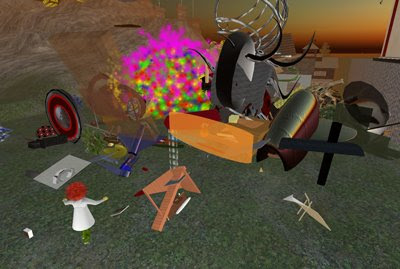The piece that was exhibited in the Off the Grid show was the “International Airport Montello”. This project is about a small and remote town in Nevada. The team worked on a 10.5 acre plot of land, (that the purchased for a small fee) on an abandoned airstrip. The piece shows the impact of a fictional airport on the citizens of the town. The artists worked very closely with the residents of the town and ended up with a personal cross section of the town. The piece is presented as a large video installation. I thought it seemed like a freeform documentary. From what I saw it lacked narrative and showed the towns people waiting for an imaginary plane while displaying their personality.
Another interesting piece that eTeam has created is the Second Life Dumpster. In this piece they purchased an area of land (4096 square meters) in Second Life where people could drop off unwanted items from their inventory. It was a public place that was open to all avatars and was left for one year. They set up a camera that took pictures every minuet of everyday thought the project. The goal of this project was to understand what kinds of items people throw away, what it means to own something in 2L, what it means to own land and what would the other avatars reactions be to the site. They documented what was happing in the dumpster in the form of a day to day database. Each day told a story of what was happing in the dumpster. They also recorded what they were doing in other areas of Second Life.
Another piece by eTeam that I find particularly interesting is "Face Trace" 2005 which is very different from their work with land concepts. This project lacked a formal description but its function is obvious. It seems to be a live installation. There is a computer program which traces a persons dominant features and projects neon lines around the person. A copy of the lines without the person is displayed on a computer screen. What results is a cartoonish image. It seems like they have kept track of the three days the piece was up on a website specifically made for the project.
Face Trace
A still from 2L dumpster in the artist database from November 19, 2007

International Airport Montello

http://www.meineigenheim.org/ (I think this is the groups official website?)









